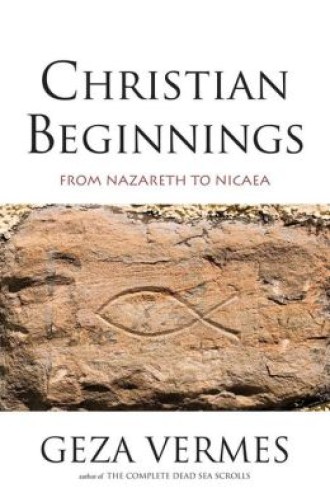How Jesus became God
Three questions guide Geza Vermes’s ambitious account of Christian beginnings. How did the charismatic movement of Jesus, based in the countryside, evolve into an institutional religion that garnered imperial favor? How did this movement, thoroughly Jewish in its participants and its emphases, morph into a predominantly gentile religion shaped by Greek philosophy and culture? As for Jesus himself, how did this charismatic figure, easily recognizable in the line of Israelite holy men from Moses to Elijah to Hanina ben Dosa, become the second person of the Trinity, consubstantial with the Father? In short, how did “the piety of Jesus, consisting of a total surrender to God and a constant search for his Kingdom,” produce a religion “primarily governed by intellectual and indeed philosophical assent”?
Vermes, who died in May, was among the scholars most qualified to address at least two of these questions. Most famous for introducing the Dead Sea Scrolls to a large audience through his ubiquitous translation and discussion, Vermes definitively shaped late 20th-century debates about the historical Jesus. Since his Jesus the Jew appeared in 1973, any credible reconstruction of Jesus’ life and teaching must make sense in Jesus’ native context. Christian Beginnings rests on his remarkable body of work: over a dozen books devoted to Jesus and earliest Christianity. Readers will be grateful that this new book includes many parenthetical references to Vermes’s other works, where they can find fuller expositions of his argument.
Read our latest issue or browse back issues.
Born in Hungary to Jewish parents who converted to Roman Catholicism in part to avoid anti-Semitism and then perished in the Holocaust, Vermes entered seminary and became a Catholic priest before eventually leaving the church altogether and returning to Judaism.
Vermes’s questions constitute standard problems for historians. At the grand level his answers will surprise few readers. Empowered by the Spirit, Jesus healed, cast out demons and brought the dead back to life. He proclaimed the kingdom’s “imminent onset”—a message somewhere between “cataclysmic” or revolutionary apocalyptic expectations and the more distant rabbinic hope that the kingdom would arrive in response to Israel’s fidelity to the Torah.
In terms familiar to other Jews, Vermes contends, Jesus identified God as a benevolent, trustworthy Father; he bore the identity Son of God because of his closeness to the divine Parent rather than as a sign of his own divinity. Torah-observant, Jesus held an outlook that was unusual only because it was “adapted for the final age,” reversing “customary priorities” by valuing the vulnerable above the devout. Vermes’s Jesus cared little for speculative theology but devoted himself to living in the light of the kingdom’s advent.
Vermes tracks how the earliest Jesus movement remained thoroughly charismatic and thoroughly Jewish, with an emphasis on faith healing, the work of the Spirit and breaking bread. In the wake of Jesus’ death these communities proclaimed him as the risen Messiah. While Paul’s circle of churches remained charismatic, the apostle added a new leadership structure, transformed Jesus “into a triumphant heavenly Son of God” and “Lord of the universe” who would soon return, and welcomed gentiles without requiring them to convert to Judaism. Johannine Christianity pushed beyond the boundaries of Pauline thought by introducing the concept of the incarnate Logos, setting the terms for christological debate over the ensuing centuries.
Readers arrive at page 154 before Vermes enters the second century. Moving beyond the New Testament, he guides readers through key figures and texts: the Didache and the Epistle of Barnabas; the so-called Apostolic Fathers; Justin, Melito and Irenaeus; Tertullian, Clement of Alexandria and Origen; and finally Eusebius, Arius and the Nicene moment. Conflicts with Jews, docetists, Montanists and devotees of gnosis pop in and out of the picture, but the story line follows the emergence of orthodoxy along the lines of institutionalization, gentile composition and Christology.
For example, the Didache shows us a final glimpse of low-structure Jewish Christianity, while Irenaeus marks the transition to the church as “a dominating principle.” Beyond the Didache lies Barnabas’s gentile audience in open conflict with Judaism, Justin’s public conflict with Jews, and Irenaeus’s preoccupation with gnostics and other internal enemies. As for Christology, the Johannine Logos motif wends its way through the discussion through figures like Ignatius, who understood Jesus as “God . . . manifest in a human way,” and Tertullian, who understood the Trinity in terms of one substance and three persons who are not coeternal. According to Vermes, prior to Nicea every significant Christian thinker articulated the Son’s subordinate relationship to the Father, and Nicea marked a “colossal” departure: “The idea of consubstantiality never occurred to any of the leading representatives of Christianity prior to 325.”
Christian Beginnings possesses formidable strengths. The writing is remarkably lucid. Drawing on his profound familiarity with ancient Judaism, and especially the Dead Sea Scrolls, Vermes demonstrates nascent Christianity’s fundamental continuities with Judaism at many points. When Barnabas provides chains of biblical proof texts, for example, Vermes reminds us that the scrolls attest to similar techniques. Most important, Vermes provides a compelling sketch of the charismatic trajectory in ancient Judaism and locates Jesus within that pattern.
Even specialists will benefit from these arguments, though they may balk at some details. For instance, Vermes discusses the problem of pseudonymity in the Pauline letters but does not apply it to Paul’s social views. He treats gnosticism as if it were a unified phenomenon. And he seems to trust the conventional narrative that Christians suffered widespread, systemic persecution. Still, given the scale of his project, I am humbled by Vermes’s erudition and reasoning.
There are other ways of telling the story. Vermes’s attention to Jewish roots, ecclesial institutionalization and doctrine certainly addresses worthy topics. But he does little to explore the ways in which the people in Jesus communities formed individual and community identities. From this book, one gathers the impression that other Christians, those not represented in the march toward orthodoxy, were rare and unimportant. Geography and the diversity that attends it play little part in Vermes’s narrative.
One emerging trend in early Christian studies runs directly counter to Vermes’s account. He never engages the growing number of scholars who perceive high Christologies at the very earliest stages of the Christian movement. Many see the Christ hymn in Philippians 2:5–11 as evidence that Christianity’s earliest literary layers identify Jesus as divine. Vermes, citing his earlier work, argues that the hymn is not part of Paul’s original letter. Mark’s Jesus forgives sins and calms the sea. Who but God wields such authority?
Daniel Boyarin, one of Vermes’s rare peers as an authority on Judaism, recently argued in his book The Jewish Gospels that Jesus viewed himself as divine. Interacting with many other scholars, Boyarin maintains that first-century CE Jewish monotheism was a lot more complicated than Vermes would acknowledge. Vermes’s account takes for granted the more familiar view that Jesus’ earliest followers, being faithful Jews, would never assign divine status to him, and he articulates that view with insight and flair.






